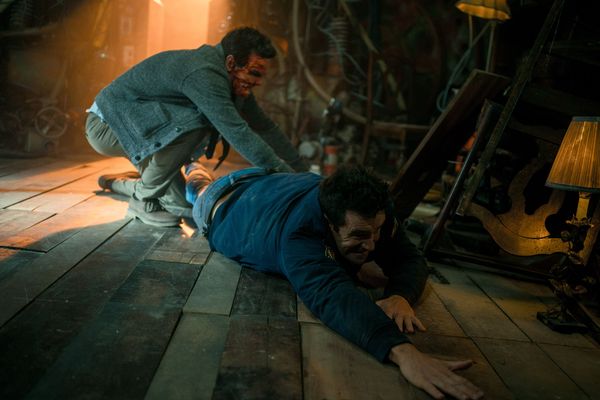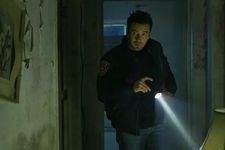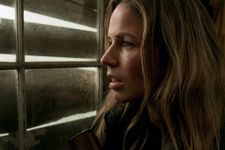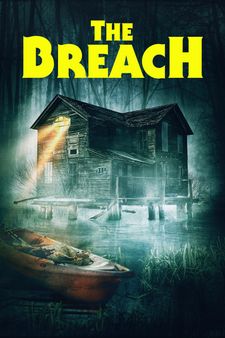 |
| The Breach |
When a body washes up on the riverbank in a remote Canadian town, it plunges a group of investigators into one of the strangest cases they’ve ever had to handle. Police procedural meets cosmic horror in Rodrigo Gudiño’s The Breach, with elements of haunted house movie and creature feature developed along the way. It’s an ambitious piece of work and not one you’ll forget in a hurry.
I first saw the film at Fantasia in 2022, and although I enjoyed it at the time, I simply didn’t have room in my schedule for any more interviews, so I was pleased to learn that it was getting a digital release – one year later – allowing me to give it the attention it deserves. Both periods were busy for Rodrigo, of course, with a great deal to do to promote the film. He was in Porta Vallarta, in Mexico, when we managed to find a mutually suitable time, and he began by telling me how the script first came his way, at the height of the early Covid pandemic, for him to consider directing.
“When I received it, it didn't have the cosmic horror. It was a bit different. It had the people going up the river and into the house where stuff happened. I really liked it, but I wanted to take it in a more unknown direction. The idea that an audience can project their own ideas into the movies really is interesting to me, certainly better than having stock creatures or whatever.
“The writers – the author, who goes by the name of Nick Cutter and is actually named Craig Davidson, and Ian Weir, his co writer – were very happy and very encouraging of change. And so I changed the script. I used that machine to generate a more cosmic, Lovecraftian situation. And I wanted to have this idea that it was a meeting place between our world and other worlds. When you have science and you have cult sciences, they meet in this weird place. So that was interesting, and then it just kept going in that direction.”
 |
| The Breach |
I tell him that I think the blend of elements works well because the characters feel very down to earth and real.
“I was very fortunate to get very, very good actors,” he acknowledges. “And especially during the time of the pandemic. I believe that reach was one of the first, if not the first film that was shot in the province of Ontario during Covid. Some of the actors, particularly Emily Alatalo, as well as Allan Hawco, they're Canadians and they understand the Canadian culture. I encouraged them to ad lib a bunch of stuff. We would do takes that were based on the script, and then just try something, just go off the script and try different things. That always gave me a final take that was not what we had planned, but super interesting, and I ended up using a lot of those. It created this feeling where, I think, there was an authenticity that was communicated.”
There’s also the mysterious character of Cole Parsons, the man whose legacy the investigators are looking into. We first get to know him through his wonderfully designed laboratory and study.
“That was the work of a gentleman named Jim Goodall, who created those spaces,” he says. “As you say, we're in this very ordinary space, and so when we get to these places where Cole Parsons has been playing, we want it to be like entering an entirely new new space. It's very out of sync with the setting of the movie, the idea being that these spaces are liminal spaces. Their purpose is to connect to another space that the film never gets to, through the machine and so on. So, yeah, we went into the mad mind of Cole Parsons and just played around there and came up with this space.”
The film is more effective because we don’t linger on the machine or other mysterious pieces of equipment for long.
“I don't know if you're familiar with some of my other movies, but I err on the side of understatement. I think that then the audience can participate in to a greater degree. Of course, when it came to this particular script, this was a creature feature, and I was committed to the idea of, at some point, letting the monsters loose. We made this decision to shoot that during the daytime scenes, which you don't often see, so you could really see what was going on in that final act. Up until that time, yeah, I'm really a big fan of the shadows and things that are unseen and things that are outside of the camera. Things you hear but don't see. All of this lets the viewer kind of participate in the movie. That's exciting.”
I suggest that there's a level of of comedy, as well, at least for people who have read their Lovecraft, when we're going down into the basement or steps are coming down from the attic in the middle of the night.
 |
| The Breach |
He smiles. “Yes, absolutely. There's definitely a lot of that element, and I think also with the character of Alex Lifeson, who’s the guy on the computer. He talks to Connie, the police officer, and I wanted some levity in there, and I wanted to bring up these ideas in a more light hearted manner. That worked for me, anyway.”
Things get a little more serious for our protagonists towards the end, when they are confronted with a number of disturbing creatures.
“I worked very closely with the effects guy, Daniel Baker. We were trying to come up with something that was a little off the beaten path, and trying to figure out what the sort of ‘science’ is behind the movie, how things would have worked. I liked this idea that this creature from another place is trying to enter into our world through human beings but is unable to do it. You know, he has a scientist helping them and they're trying to get him over, but it's always botched attempts. So I wanted to have these creatures look like botched human beings, with botched attempts by this creature trying to incarnate himself in this world. So it's a very heavy kind of concept. But we came up with some really fun ideas and I remember at one time I said ‘Daniel, why don't we pretend to put a human being in a blender and just press pause a couple of times? What would that look like?’ And we came up with these creatures. I think they worked, so we were happy.”
There’s also some horror involving eyes, which is one of those things which people often tell me they find particularly difficult to watch.
“It was all about trying to ramp up to the point where we get to the creatures. So how can we do that in a very piecemeal way? Initially we were going to do something with his eye. I don't remember what it was. But then I thought it's a really neat physical way of showing possession or someone being taken over by something where your pupil splits into two. And now you have two sort of eyes that you're looking at, even though you might only see through one. So it was really more of an insinuation, but yeah, that was fun.”
The film’s soundtrack also has an important contribution to make.
“I worked with Slash, the guitar icon, and it was great. It was just before he went on this huge Guns n’ Roses tour so we had two weeks, and I was literally shooting and cobbling together the scenes and sending it to him so he could play some music, and we’d go back and forth. He was able to do a bunch of stuff, but then at some point, he had to go on tour, and he had only scored a portion of the movie. I needed more stuff and then I remembered that I had released an album a few years ago with an artist named James Zirco Fisher. When I was in the sound room, we took some of those tracks and we stitched them into certain parts. Sometimes you only use little bits, like only a few seconds, but it worked really, really well with Slash’s stuff and the general tone. So we ended up using a bunch of stuff that James composed and then obviously Slash’s stuff. I wanted to leave the movie on a kind of celebratory note or a festive note, so we licenced the song from a band called She Past Away. It’s called Soluk. They're a Turkish goth band. There was a macabre feel to that song that I just thought worked really well.”
 |
| The Breach poster |
With not much time left, we move on to talking about the shoot, which was, he says, not quite as remote as it might appear in the film. but close to it.
“We were definitely in the middle of nowhere. We were about two hours north of Toronto in a place called Parry Sound. It's a little town and when we arrived we thought ‘Oh, this is great. We're going to have to run of this place because there’s no-one in the streets because of Covid.’ But in fact, the exact opposite was true, because all of the public parks and all the public places closed. We couldn't rent them out because of Covid. So everything you see in this movie is actually somebody's private property. We had to rent the space from them.
“We were staying in a hotel so we ended up repurposing a lot of the stuff in the hotel, but the shoot was really fun because a lot of us became very close. People would come out at night to do funk songs around the bonfire or to movie nights or whatever. Everybody ate together. It brought us really close. Normally on a film shoot you have people in trailers and everybody's in their own department, and then this time around, it was very different. It was very easy, really fun and very creative.
“In the river scene, we couldn't get down to the river all the way along, so we could only use the river for little bits and pieces. So we ended up shooting a lot of that scene in a parking lot. I'm just running around, running behind the boat, and the boat is actually being pulled by an SUV. It's moving around in a circle. And then we stitched it together with some scenes that we actually shot on the water, so you have this sense of the boat on the water, but actually, most of the time it wasn’t.” He laughs. “That’s cinemagic, right?”





















